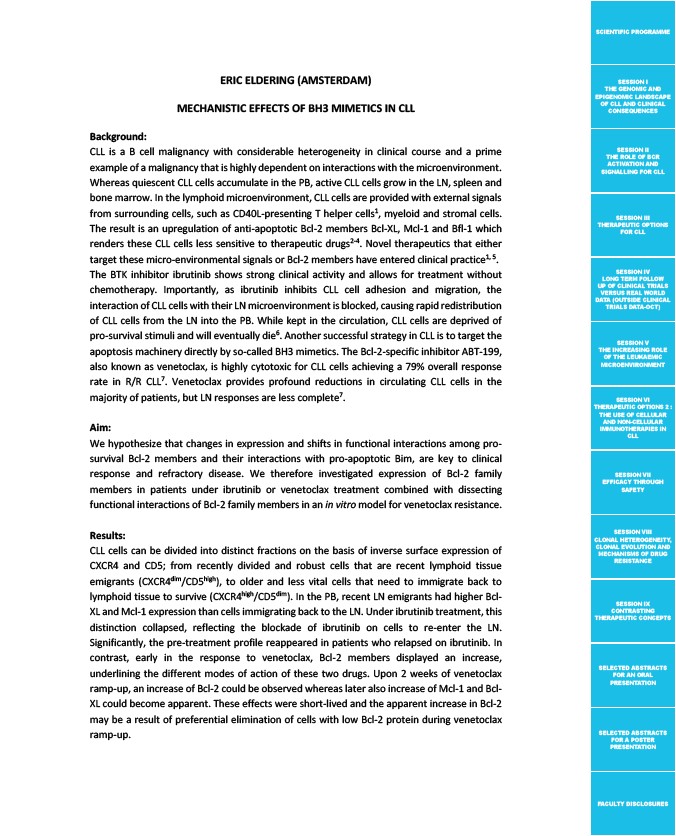
SCIENTIFIC PROGRAMME
SESSION I
THE GENOMIC AND
EPIGENOMIC LANDSCAPE
OF CLL AND CLINICAL
CONSEQUENCES
SESSION II
THE ROLE OF BCR
ACTIVATION AND
SIGNALLING FOR CLL
SESSION III
THERAPEUTIC OPTIONS
FOR CLL
SESSION IV
LONG TERM FOLLOW
UP OF CLINICAL TRIALS
VERSUS REAL WORLD
DATA (OUTSIDE CLINICAL
TRIALS DATA-OCT)
SESSION V
THE INCREASING ROLE
OF THE LEUKAEMIC
MICROENVIRONMENT
SESSION VI
THERAPEUTIC OPTIONS 2 :
THE USE OF CELLULAR
AND NON-CELLULAR
IMMUNOTHERAPIES IN
CLL
SESSION VII
EFFICACY THROUGH
SAFETY
SESSION VIII
CLONAL HETEROGENEITY,
CLONAL EVOLUTION AND
MECHANISMS OF DRUG
RESISTANCE
SESSION IX
CONTRASTING
THERAPEUTIC CONCEPTS
SELECTED ABSTRACTS
FOR AN ORAL
PRESENTATION
SELECTED ABSTRACTS
FOR A POSTER
PRESENTATION
FACULTY DISCLOSURES
ERIC ELDERING (AMSTERDAM)
MECHANISTIC EFFECTS OF BH3 MIMETICS IN CLL
Background:
CLL is a B cell malignancy with considerable heterogeneity in clinical course and a prime
example of a malignancy that is highly dependent on interactions with the microenvironment.
Whereas quiescent CLL cells accumulate in the PB, active CLL cells grow in the LN, spleen and
bone marrow. In the lymphoid microenvironment, CLL cells are provided with external signals
from surrounding cells, such as CD40L-presenting T helper cells1, myeloid and stromal cells.
The result is an upregulation of anti-apoptotic Bcl-2 members Bcl-XL, Mcl-1 and Bfl-1 which
renders these CLL cells less sensitive to therapeutic drugs2-4. Novel therapeutics that either
target these micro-environmental signals or Bcl-2 members have entered clinical practice1, 5.
The BTK inhibitor ibrutinib shows strong clinical activity and allows for treatment without
chemotherapy. Importantly, as ibrutinib inhibits CLL cell adhesion and migration, the
interaction of CLL cells with their LN microenvironment is blocked, causing rapid redistribution
of CLL cells from the LN into the PB. While kept in the circulation, CLL cells are deprived of
pro-survival stimuli and will eventually die6. Another successful strategy in CLL is to target the
apoptosis machinery directly by so-called BH3 mimetics. The Bcl-2-specific inhibitor ABT-199,
also known as venetoclax, is highly cytotoxic for CLL cells achieving a 79% overall response
rate in R/R CLL7. Venetoclax provides profound reductions in circulating CLL cells in the
majority of patients, but LN responses are less complete7.
Aim:
We hypothesize that changes in expression and shifts in functional interactions among pro-survival
Bcl-2 members and their interactions with pro-apoptotic Bim, are key to clinical
response and refractory disease. We therefore investigated expression of Bcl-2 family
members in patients under ibrutinib or venetoclax treatment combined with dissecting
functional interactions of Bcl-2 family members in an in vitro model for venetoclax resistance.
Results:
CLL cells can be divided into distinct fractions on the basis of inverse surface expression of
CXCR4 and CD5; from recently divided and robust cells that are recent lymphoid tissue
emigrants (CXCR4dim/CD5high), to older and less vital cells that need to immigrate back to
lymphoid tissue to survive (CXCR4high/CD5dim). In the PB, recent LN emigrants had higher Bcl-
XL and Mcl-1 expression than cells immigrating back to the LN. Under ibrutinib treatment, this
distinction collapsed, reflecting the blockade of ibrutinib on cells to re-enter the LN.
Significantly, the pre-treatment profile reappeared in patients who relapsed on ibrutinib. In
contrast, early in the response to venetoclax, Bcl-2 members displayed an increase,
underlining the different modes of action of these two drugs. Upon 2 weeks of venetoclax
ramp-up, an increase of Bcl-2 could be observed whereas later also increase of Mcl-1 and Bcl-
XL could become apparent. These effects were short-lived and the apparent increase in Bcl-2
may be a result of preferential elimination of cells with low Bcl-2 protein during venetoclax
ramp-up.